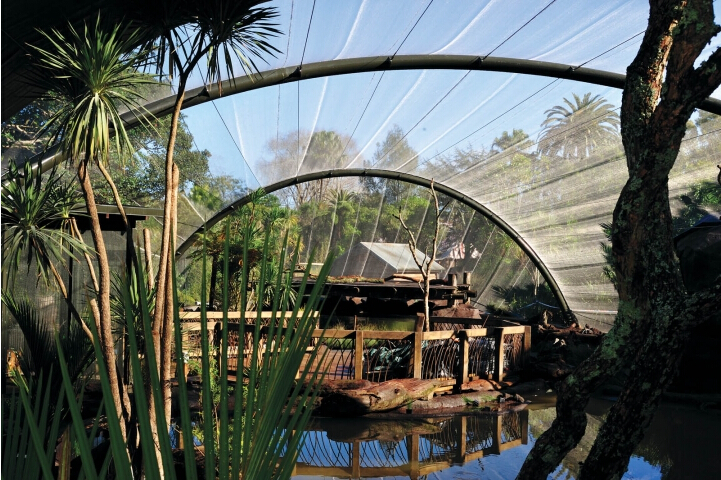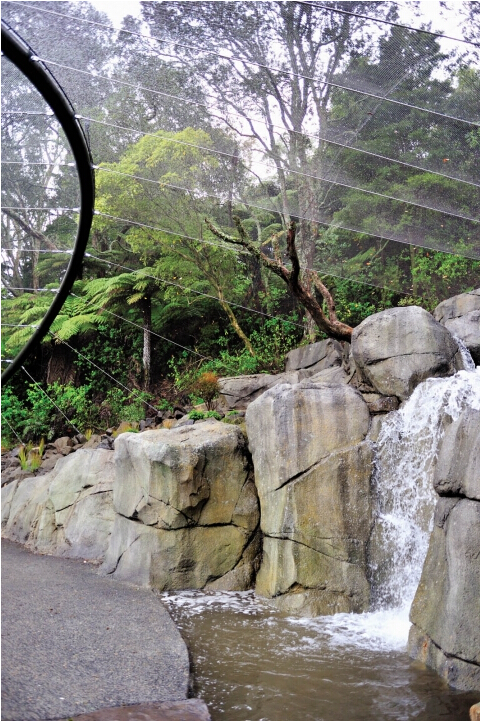Woven mesh helps the Auckland Zoo make fences disappear |
|
Author:admin Source:MSD Date:2014-12-31 14:52:08
Hits:6501
|
|
Opened in 2011, Te Wao Nui exhibit at Auckland Zoo in New Zealand offers an immersive and intimate experience of some of the Southern Hemisphere's most beautiful and rare ecologies. Like many other new zoo exhibits around the world, woven metal mesh plays a leading role in building large spatial enclosures for birds and animals while preserving a connection with the outside.
“Te Wao Nui” is the Maori expression meaning roughly, “our native bush.” Like Temaikèn Zoo in Buenos Aires, Auckland's Te Wao Nui recreates several indigenous habitats with regionally-specific plant and animal species. Yet, in contrast with zoos that interpret far-flung continents, this project focuses solely on New Zealand and six distinctive environments that have, until recently, remained undamaged by human encroachment. Long a part of Maori culture, these habitats include: The Coast (Takutai), The Islands (Moutere Rāhui), The Wetlands (Ngā Repo), The Night (Te Pō), The Forest (Te Wao Nui a Tāne) and The Country (Whenua Waotū).
Shape and tension The project required significant expertise in exhibit planning and product applications. Noted New Zealand architect and exhibit designer Logan Brewer teamed with Fabric Structure Systems (FSS) to specify and customize appropriate details and materials for four aviaries. (See sidebar for aviary type and bird species.) In explaining the unique challenges of such a complex exhibit, Warwick Bell, FSS project lead, notes, “Each aviary presented itself with separate challenges, as each was landscaped to create a different region of New Zealand and was also constrained or dictated by the existing area in which it was built.” He describes further complications where “our structures intersected with the many different styles of buildings that housed entrances and exits and other parts of the exhibits. “One of the greatest challenges was to achieve the tensile shape and tension required in the mesh in conjunction with the irregular natural and built landscape.” Yet, with its flexibility in form and scale, wire meshes proved an ideal solution. To design accurate mesh patterning for each aviary, FSS used 3-D surveying to create an accurate picture of the nuances of each site. They also tailored the mesh product for the needs of each ecosystem. For the Kea Aviary, FSS applied Phantom Mesh®, a material strong enough to resist the strong beaks of the inquisitive and sometimes slightly destructive kea parrots. For the other three aviaries, FSS used Zoo Mesh. “The mesh has good tensile shaping ability,” Bell says. As an added bonus, the FSS team was already familiar with testing and fabricating Zoo Mesh through their work three years ago designing mesh panels for the Sydney Wildlife World project—winner of an IFAI International Achievement Award. Organic adaptations FSS took part in ongoing discussions with landscape and building contractors throughout fast-track construction because even the smallest details of their daily work could affect the overall result. Bell advises exhibit designers and fabricators to form strong relationships with contractors and to maintain open lines of communication on a regular basis. Now a major tourist attraction, Te Wao Nui was funded by Auckland Council and through funds raised by the Auckland Zoo Charitable Trust. New Zealand has already seen an uptick of visitors because the “Lord of the Rings” films were shot there. Te Wao Nui will likely become part of the “must-see” itinerary. For New Zealand’s unusual coastal and inland ecologies, Te Wao Nui promises a different kind of long-term benefit. “Many of our species are found nowhere else in the world, are threatened with extinction and need the help of us all to ensure their future,” says Auckland Zoo director Jonathan Wilcken. “The zoo has been working alongside its conservation partners for years to conserve New Zealand native species. With Te Wao Nui, it’s really great to be able to finally open the door on this work to our visitors and tell the stories of amazing efforts New Zealanders have made to conserve them. Each and every one of us can play a role as kaitiaki (guardians) for our unique wildlife and wild places, and Te Wao Nui invites us all to get involved.” How it was done Phantom Mesh® Zoo Mesh The Wetlands aviary houses The Island Sanctuary aviary houses The Kea aviary houses The Blue Duck aviary houses |
|
|
|
- Zoo Animal Aviary Net
- Fence
- Anti-theft bag
- Colored Cable Netting
- Square Netting

